Disclaimer: This is only a summary with a few excerpts. If you would like to read the entire paper, please leave a comment with your email address and I will personally send it to you.
My final project, a 34-page monster titled Digital Discourse and Civic Engagement in Ukraine, examines how specific technological, structural, and discursive conditions of Internet use in Ukraine have affected democratic consolidation by promoting virtual public spheres that encourage political deliberation and civic participation.
Of course, there are numerous barriers which prevent the Internet from substantively strengthening civil society in Ukraine. First, the relatively low penetration rate of the Internet (around 20 percent) makes it difficult to sustain discourse among wide swaths of the population (Global Technology Report 2011, p. 372). Second, a generalized mistrust of Internet content as well as the identity of individual users hampers the formation of social trust and renders all information less credible. And third, although a large amount of rational-critical debate can be witnessed on online news sites and in the posts of political bloggers, the quality of web discourse is not unanimously high.
Still, the rapid growth of the Ukrainian blogosphere and the increasingly scrutinizing stance of online news publications suggest that the Internet’s function as a civic tool in Ukraine is slowly gaining force.
I. Technological Factors
– Low Internet penetration rate
Fig. 1. Internet Users in 2009 per 100 people. 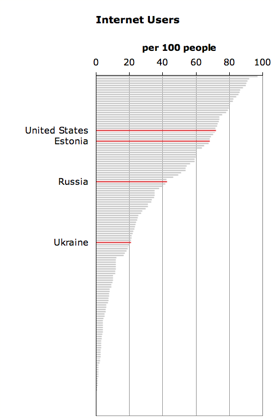
Source: The Global Information Technology Report 2010-2011, Transformations 2.0 (World Economic Forum and INSEAD, 2011), 372.
II. Structural and Institutional Factors
– Weak civil society
– Censorship and repression of traditional media
– Low trust in government
– Manipulation of Internet content by authorities.
III. A Mini-Case Study of the Blogosphere
In order to gauge the blogging’s potential as a civic platform, I address several questions. First, what do bloggers write about – topics that concern public or private interests? Second, what is the degree of rational-critical (i.e. non-hostile, logical, thought-out) discourse that takes place? And third, how do these conditions affect the blogosphere’s potential to impact offline civic engagement?
Methodology:
I only examine a small cross-section of the Ukrainian blogosphere: a total of one hundred influential blogs, based on two ranking metrics: Yandex’s list of the top fifty most “authoritative”* bloggers on www.LiveJournal.com (mostly Russian-language), and Nash-LJ’s ranking for exclusively Ukrainian-language bloggers. I assess quality of discussion in several ways. First, I hand-code blog posts in terms of their thematic focus. Overall, I examined the ten most recent posts (as of December 13th, 2011) of the top fifty Russian-language and Ukrainian-language bloggers for a total of 1000 posts. Within the broader categories of “civic” and “non-civic,” (public vs. private interests), I observed twelve main themes for blog posts.
Fig. 2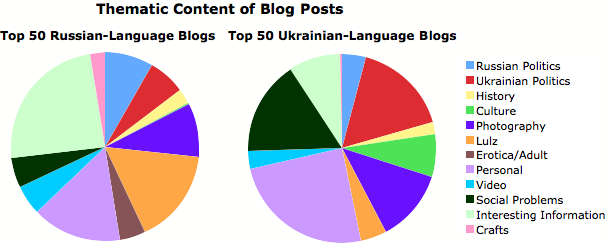
As it turns out, there are significant differences in the content of Russian-language vs. Ukrainian-language blogs.
Fig. 3 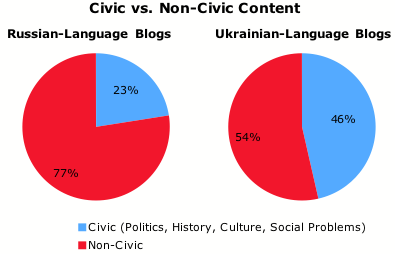
Within this section, I also examine one particularly notable example of online political satire in Ukraine. In May 2010, a gust of wind blew a large wreath onto President Yanukovych’s face during a somber salute to World War Two soldiers in Kyiv. The video quickly became an Internet sensation, and a re-mix tournament was led by LiveJournal user Kotyhoroshko, who created and collected comical renditions of the debacle. These images originated on LiveJournal.com and then rapidly spread throughout other social media.
Fig. 4. Two remixes of Yanukovych vs. the Wreath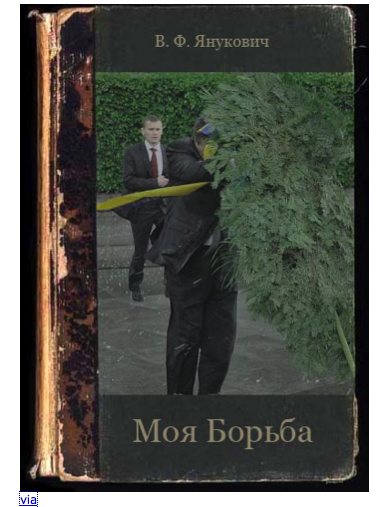

From left to right: a rendition of Yanukovych’s struggle on the cover of Mein Kampf, by LiveJournal user Ljazzy via http://kotyhoroshko.livejournal.com/446778.html; A remix by Comrade_Molotov at http://comrade-molotov.livejournal.com/1444469.html.
Next, I examine the comment threads of twenty “civic” blog entries from twelve Ukrainian-language journals and three Russian-language journals for rational-critical discourse. I begin by examining the extent to which participants are actively communicating with each other. Do comments contribute to a greater dialogue (i.e. are they responding to another comment), or are they stand-alone statements of a single user? Comments are then grouped into five different categories:
1. Passive/ Non-critical: agreement without contribution to the discussion, ex. “+1”- type comments
2. Active/ Critical: support or critique buttressed by reasoned evidence and/ or other logical appeals
3. Abrasive: flame wars, intentionally provocative or rude comments without any rational backing
4. Neutral: clarifications, off-topic tangents, and,
5. Pingback Bot: a program that some bloggers use to receive alerts when another user has linked to their post
Fig. 5. Analysis of 746 Comments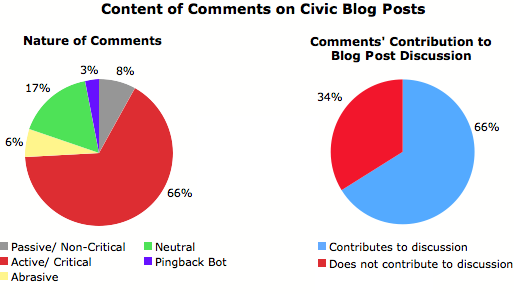
Here is an example of various comment types in action:
Fig. 6. Discussion Sample from a Blog Post at mentbuster.livejournal.com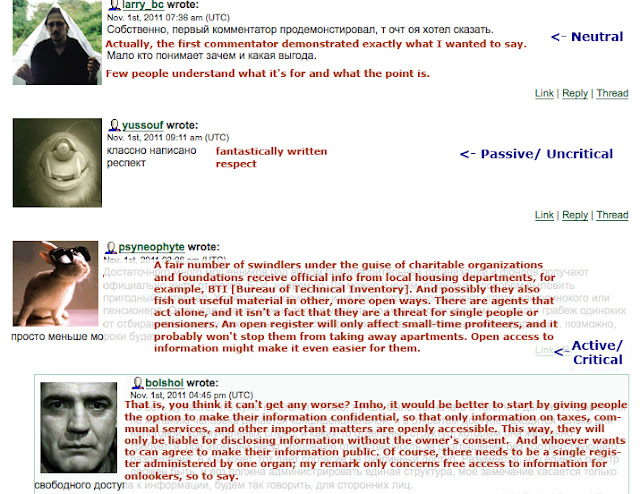
From: Tetyana Montyan, “Istinni prichiny toho, chomu nas ne klichut’ do Evropy (The real reason why they aren’t calling us to Europe),” Yuridichni provokactsii (Judicial Provocations), October 31, 2011, http://mentbuster.livejournal.com/378312.html.
Last but not least, I provide a few examples of successful local civic campaigns aided by bloggers and/or the blogosphere as a platform.
1) “Save Old Kyiv,” a movement founded in 2007 in response to the city’s plans to illegally place a modern high-rise atop of a state-protected historic site. The group promoted their cause on LiveJournal, and has since grown into a community with 754 members. Save Old Kyiv’s protests have saved numerous historic landmarks from illegal construction projects.
2) “Ukraina bez Kholopov”– “Ukraine without Villains,” a newly formed project of blogger Pavel Kolesnik aimed to combat a variety of everyday issues. Since the movement was first announced on October 29th, 2011, the group has carried out a number of “supermarket raids,” photographing expired products in major supermarket chains and documenting their ensuing scuffles with authority figures on LiveJournal.
3) In August 2010, Parliamentary Deputy Lesya Orobets was alerted via her blog about a garbage incinerator that was illegally installed by the Ukrainian Railways Company in a neighborhood of Kyiv. As a result, the incinerator was investigated, and citizens disseminated information about its health and ecological risks through online social networks. Ultimately, residents were allowed to vote on the future of the plant. Right before the voting, a Ukrainian Railways employee tweeted that the company was planning to forge the results, and urged readers to notify the mass media. No official press releases were issued, and yet five television channels and countless individual journalists showed up the voting session, thwarting the company’s plot. By November, 2010, the plant was successfully removed.**
These three cases exemplify the different ways in which online media (and, in particular, the blogosphere) can help expose information, generate public concern, and mobilize populations. However, it is also clear that the success of these actions resulted from the coalescence of different civic actors. Still, underfunded civil society organizations, inefficient bureaucracy, and a general sense of political malaise continue to hamper the formation of offline discursive arenas. Therefore, there is reason to believe that the Internet may become an increasingly important platform for civic organization and critical deliberation in years to come.
* “Authoritativeness” is based on a blog’s number of official subscribers, inbound links, and number of comments. From “Indikatory blogosfery (Indicators of the Blogosphere),” Yandex Blogs, 2011, http://help.yandex.ru/blogs/?id=1112101#1112106.
** Interview with Mykola Malukha, July 12, 2011.
